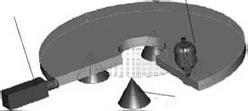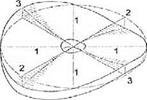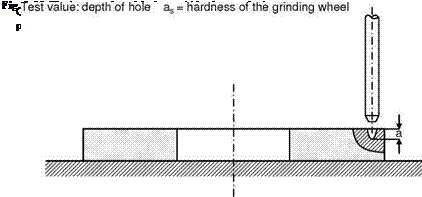For example, the stylus test is a manual testing method which does not require any apparatus. Yet it has the disadvantage of being based on the subjective impression of the tester [PEKL60a].
A further hardness-testing method which should be mentioned is the Rockwell hardness test, which proceeds in the same way as in the hardness measurement of steels. With this method, mostly very fine-grited grinding tools, like honing and oil stones, are tested.
The hardness testing methods most exploited in the grinding wheel industry are the grindo-sonic method and the Zeiss-Mackensen method. These will be explained in more detail in the following.
Hardness Testing with the Grindo-Sonic Method
In the grindo-sonic method, we have a testing method with which the elastic modulus of both grinding wheels and mounted points can be determined. The vibration-damping methods used for grinding tool hardness measurement are based on the connection between the elasticity values of the grinding tool (e. g. elastic modulus and characteristic frequency) and its hardness. The characteristic frequency f, calculated according to equation 3.8, serves as the measurand.
Here F(a, p.) is a form coefficient, which is dependent on the geometric dimensions of the body, its form and on Poisson’s ratio ц. C is the velocity of propagation of the longitudinal elasticity oscillation in the material, p is the density and E is the Young’s modulus of the body being tested.
It has been shown that there is a direct correlation between the Young’s modulus and the hardness of the grinding wheel [PETE68]. In the case of Poisson’s ratio, it has been discovered that it can be viewed as a constant for a large range of formula changes for products with vitrified bonds within the required limits of accuracy. From this, we can conclude that the hardness of the grinding wheel is derivable from the characteristic frequency insofar as the relation between CI and hardness is known and the formal coefficient F can be calculated for the size of the unit.
Fig. 3-19 shows the basic structure of the grindo-sonic testing method. The grinding wheel is laid on cones for oscillation incitation such that it is supported on four points, each at an angle of 90°, along the same diameter.
![]()
![]()


![]()

 |
By striking a location lying at two bearing points at a 90° angle, the grinding wheel begins to oscillate, whereby the nodal points of vibration are then found in the bearing points. The oscillations are recorded with the help of a piezo-electrical sensor that is mounted opposite the excitation location at an angle of 90°. The oscillation maximum is located at this point.
The monitoring apparatus attached to the sensor measures the duration of a certain number of sequential oscillation periods and shows the duration for two periods (2T) in a digital display. The indicated value of the apparatus is often referred to as the R-value.
According to equation 3.9, the characteristic frequency f [HZ] can then be computed from the values determined. The hereby computed frequencies can be assigned to hardness values as in table 3-6.
![]() f = 1.1 = -^106 .± T s 2. T jus
f = 1.1 = -^106 .± T s 2. T jus
|
Table 3-6. Comparison of hardness and elasticity modulus
|
Hardness Testing with the Sand Blasting Method as delineated by Zeiss — Mackensen
The sand blasting method, in its first form of embodiment, is based on bringing sand of a determined grit size into contact with the surface to be tested for two minutes with compressed air. The grinding wheel weight loss caused by the crater is a measure of hardness. For this kind of method, an exact determination of weight before and after the test was necessary. Due to the size of the blasted surface and the limited dimensions of the testing body, the execution of two experiments on the same body was not possible.

Sand and compressed air
The Zeiss-Mackensen testing method is a further development of the sandblasting method. Here, a volume of sand of 20 cm3 is propelled onto the grinding wheel with compressed air. The depth of the crater blown out of the grinding wheel is measured by means of test needles. This represents the measure for the bond hardness of the grinding wheel.
The problem with the Zeiss-Mackensen test method is that the dispersion of the measurements necessitates all-too frequent testing, so that the damage caused to the grinding wheel layercannot be ignored. This is especially disadvantageous in the case of superabrasive grinding wheels.
